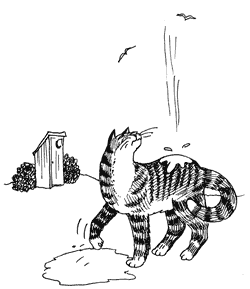STRANGE BUT TRUE- Let 'er rip: Do your do-dahs where you please

DRAWING BY DEBORAH DERR McCLINTOCK
Q. Considering potty possibilities in nature, how did humans get to do it their way (toilet trained), and cats theirs (burial), and birds and monkeys theirs (bombs away)? –A. Cummings
A. There's logic to these, as animals that just swing through trees will understandably adopt the gravity method, going wherever they please, unconcerned about befouling their living quarters, says Janine Benyus in Beastly Behaviors.
Birds, too, just let 'er rip, or if confined to nests, aim over the nestwall to keep the homesite clean. The really young ones too unagile for a rim shot may produce a fecal sac that a parent can hoist up and drop. Small wild cats return to a single defecation spot, often burying the sight and smell of their feces– the reason it's so easy to housetrain a cat but almost impossible with a monkey.
Ground-nested animals, such as deer, with nowhere to dump their offspring's dumpings, may eat them to conceal the smell from predators. Animals in burrows have similar disposal problems, and may "build their homes the way we do, with lavatory chambers separate from bedrooms or nurseries."
Q. Can psychology answer why it feels so good to get drunk on occasion? –W. C. Fields
A. A "deadened" brain won't hold as many thoughts, so doubts, anxieties, and neuroses may drop out, says University of Texas psychologist Robert Josephs. This can make you feel bolder, racier, more risktaking– the classic "disinhibited drunk."
But take away your Friday night gang, and the pleasant distractions, and your sputtering mind will have little recourse but to focus on the mood at hand– and if it's a bad one, it'll undoubtedly get worse, says Josephs, having you, in no time, "crying in your beer."
Finally, drinking is often social, and much of the high is really just being with friends. How do psychologists know this? Because they've set up "good times" situations where partygoers thought they were drinking alcoholic drinks that weren't. Didn't matter– as predicted by the "think drink" effect, they acted drunk anyway.
Q. Bedtime libido check: Do men tend to dream more about their attractive wives, former lovers, the bathing beauty next door, fantasy pinups– or other men?– S. Freud
A. Not to deflate too many balloons, but men generally dream more about other men than about women, attractive or not, whereas women are equal opportunity dreamers, splitting dreamtime 50-50, said pioneer sleep researcher Calvin Hall.
This difference appears in literally thousands of dream reports from around the world, says University of Manitoba psychologist David Koulack in To Catch a Dream. In 29 of 35 samplings taken from U.S. college students, the Zulu, the Hopi, Mt. Everest climbers, Peruvian adolescents, Guatemalan sleepers, and so forth, this gender difference showed up. The obvious explanation is that males may in fact be more important for males than are females, with males spending more significant time together, especially on the job. And so in dreams there's a mulling of these male-male camaraderies, conflicts, competitions.
One recent piece of evidence supporting this is that as women enter the workforce– still male dominated– their nightly dreamwork swings over to where the action more is– heavier on guys.
Q. What special efficiencies (or lack thereof) went into the 19th-century inventions of the Morse Code, Braille, and semaphore flag-signalling? –T.A. Edison
A. Samuel Morse's signaling code, devised by the U.S. artist and inventor during the 1830s, was guided by a letter frequency count of type found in a printer's office, says David Crystal in The Cambridge Encyclopedia of the English Language. Thus the more commonly occurring letters were assigned shorter dot/dash combinations (dot for E, dash for T, dot-dash for A, etc).
But in Braille, raised dot combinations generally increase in complexity through the alphabet: the letter A equals a single dot but U, V, X, Y and Z use 4 or more; T, the second most frequent letter in much text, uses 4 Braille dots. With semaphores, the simpler arm positions are simply assigned to the opening letters, with "T turning out to have one of the most awkward flag combinations– a fact discovered with arm-aching empiricism by generations of scouts and guides," Crystal writes.
Q. I read recently that a large pet health insurer covers hearing aids for dogs. But wouldn't they just get annoyed and try to dislodge the devices?– R. T. Tin
A. Veterinary Pet Insurance of Brea, California does reimburse for hearing assistance devices for dogs, though this isn't common, says company spokesperson Brian Iannessa. The devices typically require some behavioral training before being inserted, such as static versions (non functional) used initially to condition the dogs until they no longer feel the urge to shake their heads to dislodge the aids.
In most dogs, deafness is associated with pigmentation and is congenital and hereditary, as with blue-eyed Dalmatians, says veterinary neuroscientist George M. Strain, of Louisiana State University. Here one or both ears go totally deaf. Other causes have to do with aging, noise trauma (gun fire), infections, drug toxicity– with variable hearing loss.
Actually, dogs adapt to hearing problems well, leading happy lives if protected from dangers, including fencing or leashing away from cars. Some deaf dogs may bite as a reflex if startled, so care must be taken with small children. "Deaf dogs are good at learning sign language but can be 'visually' deaf when they choose not to look at you," says Strain, "just like guilty children."
Send Strange questions to brothers Bill and Rich at [email protected].
#